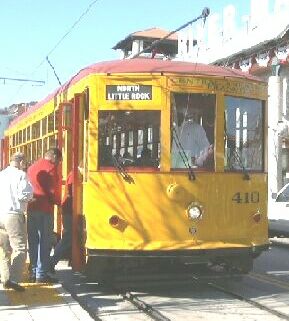
Light Rail Progress can be contacted at: Light Rail Progress |
Streetcar Success Leads to Expansion of River Rail System
The widely acclaimed success of Little Rock's new River Rail heritage streetcar system – basically, a type of light rail transit – has led to expansion of the service, expansion of the fleet, and a project to extend the system's track by approximately half a mile.
Service expansion In August (2005), the Central Arkansas Transit
Authority (CATA) board of directors voted to expand the River Rail streetcar service to run at least one car covering the entire 2.2-mi. (3.5-km) route at all times.
Previously, one streetcar would cover the Little Rock loop and another would loop through North Little Rock, crossing the Arkansas River bridge to Little Rock.
At the foot of the bridge, passengers heading into the city would have to transfer to another car, and a through
route was operated only on weekends and a couple of weekday afternoons. North Little Rock merchants had particularly lobbied CATA for the service change, convinced that potential customers from Little Rock would travel to their side of the river if there through service was provided at all times. Thus, it's hoped that the service expansion – which began September 1st last year – will foster a major boost in business for these merchants.
System expansion and upgrading Even more ambitious is CATA's program to expand the streetcar line by 2,500 feet (about 760 m) – approximately half a mile (0.8 km) – to link the Clinton Presidential Park and Library and the new global headquarters of the Heifer Project (an international charity) with the River Rail's existing route. Work is already under way to extend the trackage and power system along this new branch.
"Economic Engine That Could" What's driving this interest in local investment to upgrade and expand the River Rail streetcar system? An article last year in Passenger Transport (6 June 2005) gives some strong clues. Titled "For Little Rock, River Rail Streetcar System is the 'Economic Engine That Could', the article notes that CATA's River Rail streetcar line "is proving itself as an engine that propels more than just cars. It has electrified the economy and vitality of two downtown areas as well." The article recounts how the streetcar was envisioned as much as an economic catalyst as a mobility improvement:
And, says Passenger Transport, "Since its opening on Nov. 1, 2004, the streetcar line has been doing what was envisioned, and then some" – including fulfilling its ridership goals (1,500 to 2,900 a day, at last count). The article points to "two commercial and residential mixed-use developments costing more than $80 million" that have been announced since the River Rail opened; in addition, "existing buildings are undergoing renovation to accommodate new and intensive uses." The article highlights the example of the 118-year-old Argenta Drug Store in North Little Rock, "one of the oldest continuously operating pharmacies in the nation" and the target of a million-dollar restoration effort. "One of the streetcar objectives identified by the initial feasibility study was to provide a connection to the area's historic past" notes Passenger Transport. The restoration of the Argenta Drug Store will be a showpiece of that goal being met. Economic boost for merchants, local economy Other economic benefits flowing from the streetcar investment include "an economic boost to the many food vendors in the River Market hall, and to the restaurants and bars in the River Market District", according to Passenger Transport. The article notes that
The article cites more economic and developmental benefits associated with the River Rail:
Unique appeal of streetcars The Passenger Transport article also shed light on the importance of the connection to the Clinton Library, noting that when library visitors find the streetcar, "they also find five hotels, restaurants, three more museums, a bed and breakfast, and two riverfront parks." These aspects of the River Rail's impact help drive home a point that is often missed by some transportation planners and decisionmakers: Whether modern or "old-time", a streetcar is not just a bus fitted with steel wheels on rails. Rail services such as streetcars have both a unique appeal to the public, and a unique attraction to developers and others involved with commercial activity, in part because of the permanence and civic investment represented by their fixed facilities. In addition, other features such as electric propulsion, the traffic-calming effects of street tracks and railcars, and easily accessible surface stations enhance the surrounding environment and livability of the urban spaces they serve.
Light Rail Now website URL: http://www.lightrailnow.org/news/n_lr_2006-02a.htm Updated 2006/02/17
|
|
|
|
||